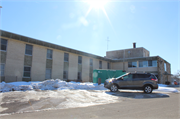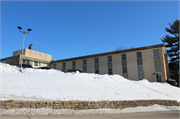| Additional Information: | 2020 WisDOT survey information:
Built into a hill and oriented on a southwest/northeast axis, the entrance of this multi-story, 1960s Contemporary-style building is oriented to E. Catherine Street. Topped with a flat roof, the entrance block projects to the northwest and is largely sheathed with stone veneer. The entrance itself is comprised of a pair of automatic sliding glass doors flanked by a single, plate-glass opening to either side and topped with a flat canopy. The second floor carries a three-light, steel-sash window. The long, linear and largely brick-clad block behind the entrance block consists of double-hung, steel sash windows separated by aggregate stone panels. Due to the uneven terrain, two stories are evident to the east, while a third (basement) level can be seen to the west. Stone veneer covers both the southwest and northwest endwalls, while the rear of the building replicates the alternating window and aggregate stone panel arrangement seen along E. Catherine Street. An additional (presumably mechanical) unit rises from the rooftop. A modern garage is located to the rear of the building, accessed from East Street, along with a large parking lot that faces STH 81/E. Louisa Street.
Construction of Lafayette Manor, a nursing home facility built in 1962, developed from the Lafayette County poor farm which was established in 1870, following the 1869 purchase of 178 acres from John J. Martin, two miles southwest of Darlington on Highway K. Following visits to Illinois homes, plans for the three-story, stone house (razed in 1973) were approved in 1870; a barn was also constructed. By 1929, the topic of improvements at the county home peaked to a point that construction of a new facility was considered and plans were prepared for a 114 x 42-foot structure to be built next to the existing structure. In early 1930, and cited as a result of “differences of opinion,” its construction was tabled indefinitely. At the onset (1870), residents of the poor house (generally orphans, handicapped or the indigent) were “committed” to the home but, as the years went on, it would evolve to house elderly persons who could care for themselves but had no home. In March 1959, a citizens advisory committee was formed to determine the need for a nursing home in the county. The farm, including the stone house, was sold in December 1959 and the eleven persons in residence were dispersed to other area homes. Despite some disagreements as to what a nursing home should be and whom it should house/care for, the decision was ultimately made for Lafayette Manor to be built near a present hospital. Funding for the $600,000 home was partially built with a $240,000 Hill-Burton federal grant that was administered by the State Board of Health and the $53,000 from the sale of the home, farm and equipment was used toward construction of Lafayette Manor. Although planned to be a 70-bed facility, the nursing home was ultimately built with a capacity of 60 beds and thirty rooms and just two blocks south of Memorial Hospital of Lafayette County. The day after the facility’s opening, it was announced that Mrs. James Seaverns was hired as the first supervising nurse. Today, the nursing home, which has a 64-bed capacity, continues to be county-owned. |
|---|
| Bibliographic References: | Footnotes for 2020 WisDOT survey information below in Additional Comments:
“Kills Proposal to Build Lafayette County Home,” The Capital Times, 10 March 1930, 14; Wallace Wikoff, “Darlington Sets Dedication Rites,” Wisconsin State Journal, 6 January 1952, 15; Louis Graham, “Lafayette County Home Studied,” Wisconsin State Journal, 30 March 1952, 15; “County Home Sold At Auction,” Stevens Point Journal, 31 December 1959, 2; “Lafayette Board Will Sell Home,” Wisconsin State Journal, 13 November 1959, 7; Louis Graham, “Nursing Home Issue Revived,” Wisconsin State Journal, 7 February 1960, Section 2, page 2; “Proposal on New Unit First Shelved in 1930,” Wisconsin State Journal, 7 February 1960, Section 2, page 2; “State Board Okays Grants,” Portage Daily Register, 12 August 1960, 1; “Lafayette Plans New County Home,” Wisconsin State Journal, 19 February 1961, 17; “Area Building Projects Booming, Wisconsin State Journal, 23 July 1961, Section 2, pages 1-2; “Readstown Pair Moves to Darlington,” The La Crosse Tribune, 16 August 1962, 1; “Lafayette Manor Boiler Backfires,” The Capital Times, 7 November 1962, 29; “Pleasant Acres Is Oldest County Home in Wisconsin,” The Oshkosh Northwestern, 11 February 1964, 17; 103-Year-Old Landmark Lafayette County Home Torn Down,” Wisconsin State Journal, 6 February 1973, Section 4, page 1. |
|---|


